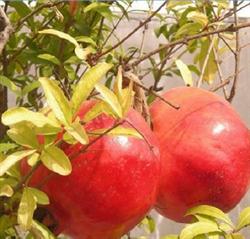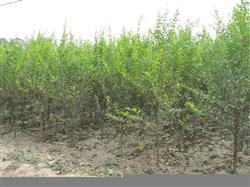Pollution-free pomegranate fertilization technology

First, the key to whether the fertilization period is scientific and reasonable is to grasp several critical periods of pomegranate tree growth and development. Pomegranate tree fertilization is divided into base fertilizer and topdressing fertilizer. Base fertilizer generally uses high-quality organic fertilizer, which can balance the supply of various nutrients to pomegranate trees all the year round. The best application of base fertilizer in autumn, combined with deep soil application, is the second growth peak of pomegranate root system, the new root has many roots, the growth rate is fast, the cut root is easy to heal and regenerate, and the white absorbing root can absorb part of the nutrition. it is beneficial to restore the tree potential and increase the reserve nutrition, and most of the organic matter can be fully matured in the soil and can be absorbed and utilized in the flowering and budding stage of pomegranate in spring. The determination of topdressing period is mainly based on the process of phenological phase and the need of growth and fruiting to supplement nutrition in time. The main results are as follows: (1) topdressing before sprouting and after flowering: mainly to supplement the deficiency of storage nutrition, improve fruit setting rate and shoot growth, mainly compound fertilizer. (2) topdressing during expansion period: promote shoot growth and flower bud differentiation, apply appropriate amount of nitrogen fertilizer and more phosphorus and potassium fertilizer, mainly ternary compound fertilizer. (3) pre-harvest topdressing: mainly available potassium fertilizer, which can promote fruit expansion and improve fruit quality, which is generally applied 15 days before harvest. (4) Postharvest topdressing: mainly topdressing for varieties that consume a lot of nutrients or trees with weak tree potential, which can enhance tree potential and increase reserve nutrition. Second, reasonably determine the amount of fertilizer application 1. Organic fertilizer is used as the basic fertilizer of pollution-free pomegranate. According to the fertilization level of pomegranate production in our district, the amount of organic fertilizer applied in pollution-free pomegranate production should be 4000-5000kg per mu, but only 600-800kg per mu in production, and the application of organic fertilizer is seriously insufficient, which increases the application rate of chemical fertilizer, which is also one of the reasons for the decline of pomegranate quality. organic fertilizer can improve soil, increase soil capacity, reduce environmental pollution, and significantly improve the yield and quality of pomegranate. two。 Soil testing and formula fertilization. Soil testing and fertilization plays an important role in increasing fruit setting rate and increasing yield continuously and stably. In order to determine the amount of soil fertilizer application, we should not only consider the growth of pomegranate orchard, fertilizer use efficiency and pomegranate growth and other factors, but also comprehensive analysis, increase or decrease as appropriate. According to the determination, the suitable amount and proportion of nitrogen, phosphorus and potassium in 2300kg pomegranate orchard per mu are pure nitrogen 21.2kg/ mu, pure phosphorus 18.4kg/ mu, pure potassium 9.6kg/ mu, and N:P2O5:K2O is 14:18:18, and the suitable formula ratio is related to pomegranate yield and soil N, P, K nutrient content. Therefore, the suitable amount of various fertilizers should be determined according to different pomegranate yield, level and soil fertilizer supplying capacity. Third, fertilization methods apply fertilizer scientifically according to the characteristics of pomegranate fertilizer requirements and the characteristics of various chemical fertilizers. The young trees are applied with annular ditch, which is located at the outer edge of the crown, and the radial ditch is applied at the full fruit stage. According to the root distribution, the radial ditch should be dug into the form of shallow inside and deep outside. About 10-20cm at one end of the trunk and about 30-40cm at the far end of the trunk. The clay soil is hard and the soil with strong fertilizer conservation can be applied deeply to guide the root system to expand to the deep, while the sandy soil is easy to lose nutrients and is suitable for shallow application. The location of the radiation ditch should be changed every year in order to achieve the purpose of land reform in the whole garden. Fourth, scientific application of micro-fertilizer with the continuous improvement of pomegranate yield and the reuse of old pomegranate orchard, a large number of nutrient elements are taken away from the soil every year, resulting in the lack of some trace elements. At present, the quality and yield of pomegranate have been affected by the lack of trace elements such as zinc and boron in pomegranate orchards. When pomegranate lacks catalpa, it sprouts late in spring, fine leaves are clustered, leaves are small, flower buds are reduced, fruit is not easy to bear fruit, fruit is small, root system of newly diseased young trees is poor, root system of old diseased trees is rotten, crown is sparse, can not be expanded, and the yield is very low. Preventive measures: (1) soil application method: zinc sulfate 0.1kg is applied in combination with fertilization plants, and this method is valid for a long time. (2) foliar spraying: zinc sulfate solution was sprayed 1-2 times 2-3 weeks before flowering. The proportion of zinc sulfate solution is 36%, that is, zinc sulfate 1kg, quicklime 0.7kg, water 200kg, this method can not only reduce the production of small fruit, but also increase the fruit setting rate. When the pomegranate orchard was boron deficient, irregular gangrene appeared at the top of the pomegranate orchard, the upper leaves were yellowed, when the pomegranate orchard was moderately deficient, the terminal bud died, the growth stopped, and the tip withered at the end. Preventive measures: 1220.2% borax or 0.1% boric acid can be sprayed 2-3 times as foliar fertilizer before and after the initial flowering stage; 20g borax can also be applied in combination with fertilizing plants. The root application of micro-fertilizer should be combined with the application of spring fertilizer or autumn fertilizer, and pay attention to the amount should not be too much, so as not to cause fertilizer damage.
- Prev

Cultivation techniques of young pomegranate
Pomegranates are light-loving, drought tolerant, barren tolerant, fruiting early and easy to manage. They are important economic tree species in mountainous areas. In the young stage, we should do a good job of the following cultivation measures: First, select good seedlings 1, select good varieties of pomegranate can be divided into sweet, sour, sour three categories, such as no special needs, in the cultivation of...
- Next

Points for attention in pomegranate pruning
Pomegranate is sensitive to pruning, improper pruning will cause the tree to grow too long or the tree is too weak. Because the trunk of pomegranate is not obvious, when planting in the courtyard, the umbrella should be used to open the shape, and the trunk should leave branches above 1.2 meters. Field cultivation should be dominated by flat-headed longitudinal branches.
Related
- Moge, come on! The staff of the peasant association in the producing area of cantaloupe were frightened when the crowd gathered.
- Causes and Solutions of low Fruit setting rate of Apple
- Symptoms and control measures of passion fruit virus disease
- Fruit growing lesson: how do apple orchards keep high yields?
- Can you build orchards in the mountains? What are the pros and cons?
- How to manage the coloring period of Crisson grape?
- This paper introduces the processing technology of two kinds of fig products.
- How much is a month for retired teachers in rural areas by 2020?
- How can strawberry planting increase sugar content? We should pay attention to management in many aspects.
- What are the cultivation techniques on how to improve the yield of golden fruit?

